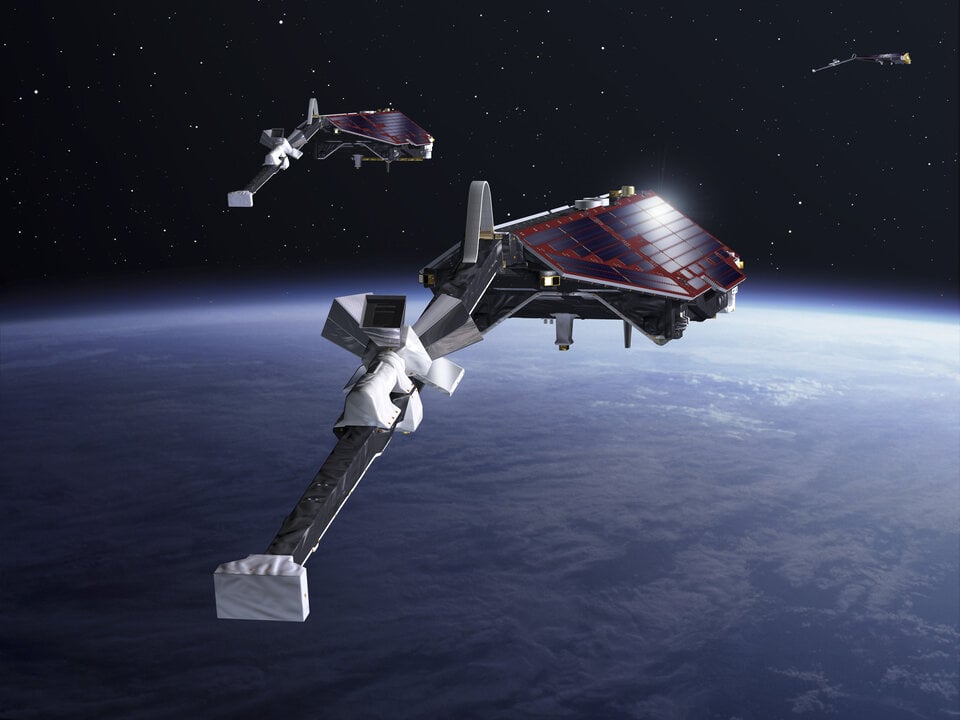The phrase "when it rains, it pours" is commonly used in the US to denote that bad things usually happen simultaneously. And it doesn't only have to apply to things that happen where it can physically rain. Recently an ESA satellite had a series of bad things happen that could potentially have happened to it, but quick action from the team responsible for the satellite avoided two what could have been catastrophic events.
Swarm, the satellite system that had a terrible day recently, is actually composed of three satellites A (Alpha), B (Bravo), and C (Charlie). To perform their mission of studying Earth's magnetic field, the three satellites must fly in close coordination and maintain distance from one another. So there was a bit of panic when the Swarm team got notice that Alpha had a very high likelihood of getting hit by an unknown piece of space debris in less than eight hours.
Avoiding space debris is common among all satellites - on average, an ESA satellite has to dodge about two pieces per year, with many, many more potential warnings coming down the pipeline from ESA's Space Debris Office and the US Space Surveillance Network. Usually, those warnings come with at least 24-hour notice, so an eight-hour timeline was much tighter than usual.
Part of the reason that time crunch matters is how difficult it is to pick where and how to dodge. Considerations like other potential collisions, fuel consumption, the safe distance needed from the debris, and many other factors are all included in the decision-making process. Making those decisions in a few hours would be stressful for anybody.
On top of that already shortened timeline, Swarm was already undergoing a series of orbital correction maneuvers to avoid another potential hazard - Earth's own atmosphere. Swarm has been residing in an orbit that is exceptionally responsive to differences in solar activity. When there are more sunspots, the atmosphere around Swarm gets "thicker," slowing the craft down.
Right now, the Sun is undergoing an increase in solar activity as part of one of the spikes in its solar cycle, creating more drag for Swarm than it had previously been affected by. Over the medium term, this could have caused Alpha and Charlie to switch places in their orbits, effectively stopping the mission from being able to collect data. Even worse, if left unchecked, the satellites themselves could have been slowed enough to a point where they were wholly dragged out of the sky.
One of the 25 maneuvers planned to avoid this fate for Alpha was to take place only a few hours after the satellite was forced to dodge this incoming debris. The impeding dodge put a hold on that step in the process, but holding off for too long would cause issues in maintaining satellite formation.
So the ESA engineers and scientists did what engineers and scientists occasionally have to do when projects are threatened - they "got to work with a reaction time to rival an Olympic sprinter," according to a press release. They had planned and executed an orbital change within four hours to avoid the debris. Less than twenty-four hours later, they performed an updated maneuver to put Swarm back on track to get out of the slowly thickening atmosphere.
Avoiding space debris will only grow in importance to satellites, lest we become a civilization affected by Kessler syndrome. The technology and resources are in place to ensure that that doesn't happen. Now we must continue to utilize them correctly, no matter how bad the weather is.
Learn More:
ESA - Swarm dodges collision during climb to escape Sun’s wrath
UT - We Need to Fix Space Junk Before It’s Too Late
UT - Is Earth’s Magnetic Field Ready to Flip?
UT - Ground-Based Lasers Could Push Space Debris off Collision-Course Orbits
Lead Image:
Artist's impression fo a Swarm satellite.
Credit - ESA - P. Carril
 Universe Today
Universe Today

